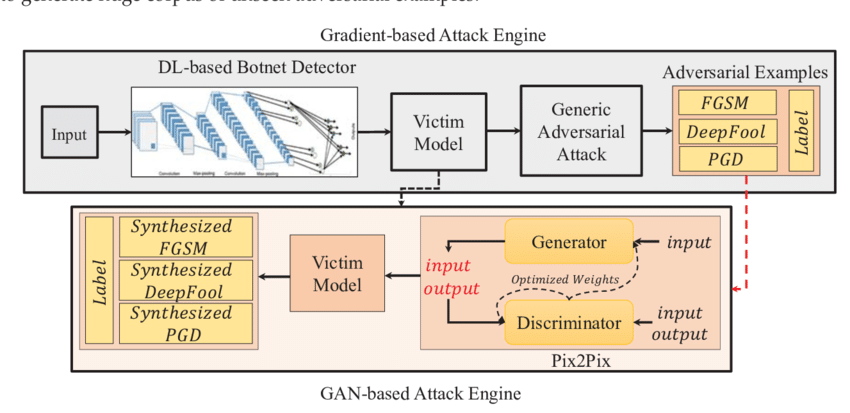
Adversarial attacks on Generative Adversarial Networks (GANs) refer to a type of malicious manipulation or interference with the functioning of GANs, which are a class of artificial intelligence (AI) algorithms used for generating synthetic data. GANs consist of two neural networks, a generator and a discriminator, that work in tandem to produce realistic data samples. The generator creates synthetic data samples, while the discriminator evaluates the authenticity of these samples by comparing them to real data samples. Through this process of competition and collaboration, GANs are able to generate high-quality synthetic data that closely resembles real data.
Adversarial attacks on GANs involve intentionally perturbing the input data to the GAN in order to deceive or disrupt its functioning. These attacks can take various forms, such as adding noise or altering the input data in a way that causes the GAN to produce incorrect or undesirable outputs. The goal of adversarial attacks on GANs is to exploit vulnerabilities in the GAN’s architecture or training process to manipulate its output in a way that benefits the attacker.
One common type of adversarial attack on GANs is known as the “poisoning attack,” where the attacker injects malicious data samples into the training dataset used to train the GAN. By introducing these poisoned samples, the attacker can influence the GAN’s learning process and bias its output towards generating specific types of data. Another type of adversarial attack on GANs is the “evasion attack,” where the attacker manipulates the input data to the GAN in a way that causes it to produce incorrect or misleading outputs. Evasion attacks can be used to deceive the GAN into generating data that is different from the intended output.
Adversarial attacks on GANs pose a significant threat to the reliability and security of AI systems that rely on GANs for generating synthetic data. These attacks can have serious consequences, such as compromising the integrity of data generated by the GAN, leading to incorrect decisions or actions based on the manipulated data. Adversarial attacks on GANs can also undermine the trust and credibility of AI systems that use GANs, as users may become wary of relying on the authenticity of the generated data.
To defend against adversarial attacks on GANs, researchers have developed various techniques and strategies to enhance the robustness and security of GANs. One approach is to incorporate adversarial training into the GAN’s training process, where the GAN is exposed to adversarial examples during training to improve its resilience to attacks. Another approach is to use techniques such as input sanitization and anomaly detection to detect and mitigate adversarial attacks on GANs in real-time.
In conclusion, adversarial attacks on GANs are a serious threat to the reliability and security of AI systems that use GANs for generating synthetic data. By understanding the nature of these attacks and developing effective defense mechanisms, researchers can help safeguard AI systems against the potential risks posed by adversarial attacks on GANs.
1. Security concerns: Adversarial attacks on GANs highlight potential vulnerabilities in AI systems that could be exploited by malicious actors.
2. Robustness testing: Understanding adversarial attacks on GANs can help researchers develop more robust AI models that are resistant to such attacks.
3. Ethical implications: Adversarial attacks on GANs raise ethical questions about the potential misuse of AI technology for malicious purposes.
4. Improving AI defenses: Studying adversarial attacks on GANs can lead to the development of better defense mechanisms and strategies to protect AI systems.
5. Advancing AI research: Research on adversarial attacks on GANs can contribute to the advancement of AI technology and the development of more sophisticated models.
1. Generating realistic images for applications such as computer graphics, virtual reality, and image editing
2. Creating deepfake videos for entertainment or malicious purposes
3. Improving image generation in medical imaging for diagnosis and treatment planning
4. Enhancing image recognition and classification in security systems and surveillance technology
5. Developing autonomous vehicles with improved object detection and scene understanding
6. Enhancing natural language processing for chatbots and virtual assistants
7. Improving recommendation systems for personalized content delivery
8. Enhancing fraud detection and cybersecurity measures
9. Developing AI-powered creative tools for artists and designers
10. Improving data augmentation techniques for training machine learning models.
There are no results matching your search
There are no results matching your search